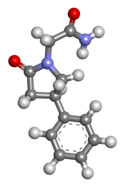Phenylpiracetam
This article has multiple issues. Please help improve it or discuss these issues on the talk page. (Learn how and when to remove these template messages)
|
 | |
 | |
| Clinical data | |
|---|---|
| Trade names | Phenotropil; Carphedon |
| Pregnancy category |
|
| Routes of administration | Oral (tablets) |
| ATC code |
|
| Legal status | |
| Legal status |
|
| Pharmacokinetic data | |
| Bioavailability | ~100% |
| Metabolism | None |
| Elimination half-life | 3–5 hours |
| Excretion | Urine (~40%), bile and perspiration (~60%) |
| Identifiers | |
| |
| CAS Number | |
| PubChem CID | |
| ChemSpider | |
| UNII | |
| ECHA InfoCard | 100.214.874 |
| Chemical and physical data | |
| Formula | C12H14N2O2 |
| Molar mass | 218.3 g/mol g·mol−1 |
| 3D model (JSmol) | |
| Chirality | Racemic mixture |
| Boiling point | 486.4 °C (907.5 °F) |
| |
| |
| | |
Phenylpiracetam (INN: fonturacetam,[1] brand names Phenotropil, Carphedon), also called is a phenylated analog of the drug piracetam which was developed in 1983 in Russia where it is available as a prescription drug. Research on animals has indicated that phenylpiracetam may have anti-amnesic, antidepressant, anticonvulsant, antipsychotic, anxiolytic, and memory enhancement effects.[2][3]
Pharmacology
A few small clinical studies have shown possible links between prescription of phenylpiracetam and improvement in a number of encephalopathic conditions, including lesions of cerebral blood pathways, traumatic brain injury and certain types of glioma.[4]
Phenylpiracetam reverses the depressant effects of the benzodiazepine diazepam, increases operant behavior, inhibits post-rotational nystagmus, prevents retrograde amnesia, and has anticonvulsant properties.[2][5][6]
Phenylpiracetam is typically prescribed as a general stimulant or to increase tolerance to extreme temperatures and stress.[7]
In Wistar rats with gravitational cerebral ischemia, Phenylpiracetam reduced the extent of neuralgic deficiency manifestations, retained the locomotor, research, and memory functions, increased the survival rate, and lead to the favoring of local cerebral flow restoration upon the occlusion of carotid arteries to a greater extent than did piracetam.[8]
In rats, it has been found to decrease the number of nACh and NMDA receptors and increase the density of D1, D2 and D3 receptors.[5]
Availability

While not prescribed as a pharmaceutical in the West, in Russia it is available as a prescription medicine under the name Phenotropil (but most drugstores sell it without prescriptions).[citation needed]
Phenylpiracetam has recently gained niche popularity from online nootropics suppliers in the U.S. and other countries outside of Russia. Phenylpiracetam is not scheduled by the DEA in the U.S.[9]
Athlete doping
Because it increases physical stamina and provides improved tolerance to cold weather, it appears on the lists of stimulants banned for in-competition use by the World Anti-Doping Agency. This list is applicable in all Olympic sports.
See also
- Doping in sport
- Methylphenylpiracetam, a methylated analog
- Phenylpiracetam hydrazide
- Phensuximide, a succinimide analog
- Racetams
References
- ^ "WHO Drug Information, Vol. 24, No. 1, 2010" (PDF). p. 56. Retrieved 31 December 2015.
- ^ a b Malykh, A. G.; Sadaie, M. R. (2010). "Piracetam and Piracetam-Like Drugs". Drugs. 70 (3): 287–312. doi:10.2165/11319230-000000000-00000. PMID 20166767.
- ^ Zvejniece L, Svalbe B, Veinberg G, Grinberga S, Vorona M, Kalvinsh I, Dambrova M (2011). "Investigation into stereoselective pharmacological activity of phenotropil". Basic & Clinical Pharmacology & Toxicology. 109 (5): 407–12. doi:10.1111/j.1742-7843.2011.00742.x. PMID 21689376.
- ^ Savchenko, A. I.; Zakharova, N. S.; Stepanov, I. N. (2005). "The phenotropil treatment of the consequences of brain organic lesions". Zhurnal nevrologii i psikhiatrii imeni S.S. Korsakova. 105 (12): 22–26. PMID 16447562.
- ^ a b Firstova, Yu. Yu.; Abaimov, D. A.; Kapitsa, I. G.; Voronina, T. A.; Kovalev, G. I. (2011). "The effects of scopolamine and the nootropic drug phenotropil on rat brain neurotransmitter receptors during testing of the conditioned passive avoidance task". Neurochemical Journal. 28 (2): 130–141. doi:10.1134/S1819712411020048.
- ^ Bobkov, I.; Morozov, I. S.; Glozman, O. M.; Nerobkova, L. N.; Zhmurenko, L. A. (1983). "Pharmacological characteristics of a new phenyl analog of piracetam--4-phenylpiracetam". Biulleten' eksperimental'noi biologii i meditsiny. 95 (4): 50–53. PMID 6403074.
- ^ Kim, S.; Park, J. H.; Myung, S. W.; Lho, D. S. (1999). "Determination of carphedon in human urine by solid-phase microextraction using capillary gas chromatography with nitrogen-phosphorus detection". The Analyst. 124 (11): 1559–1562. doi:10.1039/a906027h. PMID 10746314.
- ^ Tiurenkov IN, Bagmetov MN, Epishina VV (2007). "Comparative evaluation of the neuroprotective activity of phenotropil and piracetam in laboratory animals with experimental cerebral ischemia". Eksp Klin Farmakol. 70 (2): 24–29. PMID 17523446.
- ^ List of Controlled Substances

